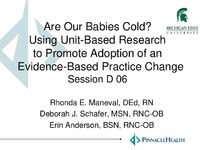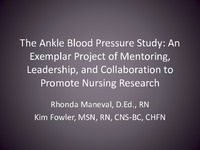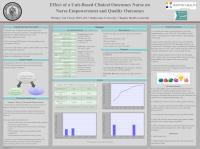| dc.description.abstract | <p>Session presented on Monday, November 9, 2015:</p>
<p>The purpose of this presentation is to share the experience of one maternal-child unit as it transitioned skin to skin care from the post-operative anesthesia unit (PACU) to the operating room (OR) for infants delivered via cesarean section. The desire to change the protocol to begin skin to skin care in the OR was the result of a unit-based EBP project. The new protocol called for the infant to be placed skin-to-skin with the mother in the operating room provided both mother and neonate were stable. The practice follows the procedure described by Haxton, Doering, Gingras, & Kelly (2012) by "placing the naked newborn prone on the mother's bare chest at birth or soon afterward". After this change was instituted some nurses began anecdotally reporting perceived higher rates of neonate hypothermia. Although currently published literature supports early skin to skin care as safe, there was continued concern from some nurses. In response to these concerns a team was assembled to investigate and develop a plan. The team included two experienced BSN staff nurses, the department's clinical nurse specialist (CNS), and an academic nurse researcher. The clinical issue of newborn hypothermia as a result of early skin to skin after cesarean delivery was challenging for the team, since an EBP project had already addressed the issue of safety, including temperature regulation of the newborn. The first option considered by the team was to provide additional education to nurses on the evidence supporting the new protocol. However, informal discussions with nurses revealed that some were not convinced by this evidence primarily because their own experience with low newborn temperatures. It did not appear that more education would be enough to change opinions on the safety of the new protocol; however, the team did not want to dismiss the nurses' concerns, since doing so might be detrimental to the culture of inquiry that had been established on the unit. It was decided that the best course of action would be to systematically investigate the concern by undertaking a study involving newborns cared for on the unit. The team felt that by performing the study on the unit the results would be more meaningful to the nurses since it would involve newborns to whom they had provided care. A retrospective descriptive study was proposed and received IRB approval prior to initiation. The goal of the study was assess maternal and neonatal body temperature postoperatively while skin-to-skin care was being performed. A sample of 201 healthy, uncomplicated cesarean delivery mother-baby dyads, who were patients during the previous 12 months, was included in the study. Data were collected through retrospective electronic chart review. A data collection tool was utilized and inter-rater reliability was established. Data included demographic information, BMI, gestational age, gravidy and parity, number of cesareans, co-morbidities, IV fluid, EBL, spinal medications, OR case time, use of pressers by anesthesia, L&D admission temperatures, PACU temperatures, and the first 3 neonatal temperatures obtained at 30, 60, and 90 minutes of age, respectively. The results of the study related to newborn temperature suggestion that only a very small number of infants, less than 5 percent, experienced hypothermia within the first hour and half of life. Of these infants only four (4) had temperatures less than 36.0 C, while the others temperatures ranged between 36.1 and 36.4. Over eighty percent (80.1%) of newborns had a normal temperature (36.5 to 37.4) at the first reading (30 minutes), by the second reading (60 minutes) ninety-one (91%) were normal, and by the third reading (90 minutes) over ninety-five percent (95.3%) were normal. Additionally, the mean newborn temperature at all three measurement points was the same at 36.7. Additional analysis is underway and will be shared at the conference. The team is working on strategies for dissemination of results to unit nurses. Part of this planning process is to meet with the informal nurse leaders on the unit and share results directly with them in a small group setting. This will allow for questions and an opportunity for the team to address any continuing concerns. Other strategies will include the creation of a poster about the study so that it can be displayed on the unit. An added benefit of this strategy is that patients and their families will also have an opportunity to view the poster and learn about the study and the protocol. A one-page informational flyer will also be created and distributed to staff as a way of communicating the study results directly with them. This will be placed in their physical mailboxes as well as delivered via their hospital email account. An additional strategy we will employ will be hosting information sessions that will offer continuing education credit. This will provide an opportunity for nurses to hear the information and to discuss and engage openly with their peers. There are three main outcomes we hope to achieve as a result of this project. One is to develop informal unit leaders as early skin to skin champions. We believe they will be critical to the success and sustainability of the early skin to skin practice in the OR. We also hope that this project communicates the value and respect the organization has for the expertise of the nurses and that this will further the cohesiveness of the unit. Lastly, it is the hope of the team that this project will result in a renewed spirit of inquiry on the unit, with nurses feeling supported and engaged. It is our goal that they continue to ask questions about their practice and bring forward issues that may impact patient outcomes negatively. It was because of this culture of inquiry that nurses felt comfortable questioning the new skin to skin practice. It was critical to the team that this questioning be supported, so rather than attempt re-education or otherwise convince nurses that the new protocol was safe the team decided to undertake a research study to directly address their concerns. We believe this was a positive and respectful response to the issue and perhaps a strategy others might choose to use.</p> | en |





